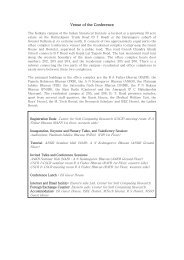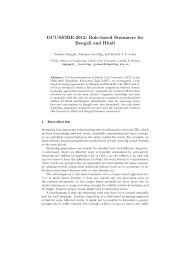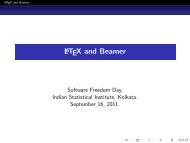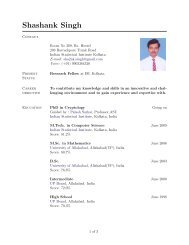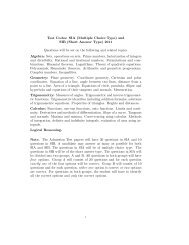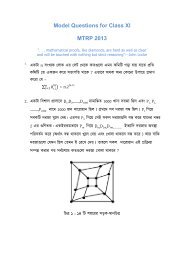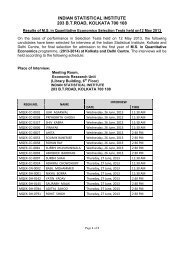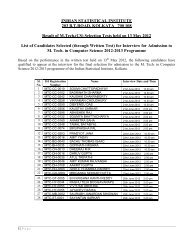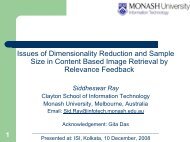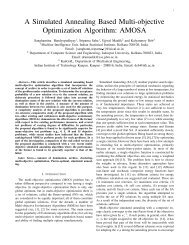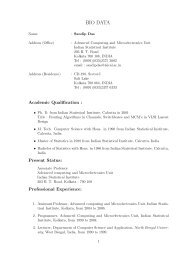Hindi Stemmer @FIRE-2013 - Indian Statistical Institute
Hindi Stemmer @FIRE-2013 - Indian Statistical Institute
Hindi Stemmer @FIRE-2013 - Indian Statistical Institute
Create successful ePaper yourself
Turn your PDF publications into a flip-book with our unique Google optimized e-Paper software.
<strong>Hindi</strong> <strong>Stemmer</strong> <strong>@FIRE</strong>-<strong>2013</strong>Anubha Jain 1 and Sujoy Das 21 Research scholar, Department of Computer Applications, MANIT, Bhopal2 Associate Professor, Department of Computer Applications, MANIT, Bhopal(jain05anubha@gmail.com, sujdas@gmail.com)Abstract. This paper describes a language independent approach for extracting <strong>Hindi</strong> morphemefrom a given list of <strong>Hindi</strong> words of morpheme extraction task (MET) at FIRE <strong>2013</strong>.In this approach list of <strong>Hindi</strong> word is submitted to the system and it generates stemmed <strong>Hindi</strong>root word from it. The proposed approach has shown an improvement of 3.40% over baselineresult. The approach is applied on <strong>Hindi</strong> language but it may also be used for any otherlanguage due to its language independent nature.Keywords. <strong>Stemmer</strong>, Prefixes, Suffixes, Morpheme.1 IntroductionIn many of the domains where natural language is processed, depending upon the task, obtainingroot or stem word from its inflected form may prove to be one of the most important preprocessingtasks. The process may be used to control number of index term that may be present at thetime of indexing or may be useful at the time of query formulation. Controlled vocabulary at thetime of indexing may improve retrieval performance [1]. <strong>Stemmer</strong> and lemmatizer are used toextract the lexical and grammatical morphemes of the original words [4].Morpheme extractionare a technique that is used for extracting morphemes from the inflected form of words. The systemis referred as stemmer which is used for getting the stem, base or root form of any word. Themorpheme extraction results in two classes of words i) Stem and ii) Affixes (Prefix, suffix etc.).Stem words are root/base form whereas affixes are used to modify the meaning or grammaticalfunction of root word [2]. <strong>Hindi</strong> has large number of affixes rather than English [2]. In <strong>Hindi</strong>सदस्, ब ल्लेबा, दृश, आश् are root words and some of the affixes are य, ओं, अन, अनीय,अत, अन ्etc.<strong>Stemmer</strong> can be rule based or statistical. In rule based stemmer predefined rules are usedto design stemmer whereas statistical information of the corpus may be used to obtain root orbase form [3][5]. Number of stemmers like Porters, Krovetz and Lovins [6][7], with their ownpros and cons are used in English language but there is a need to develop a mature <strong>Hindi</strong> languagestemmer.
2 MethodologyIn this paper an attempt is made to extract root/stem word from list of words of <strong>Hindi</strong> language.The approach is language independent as it does not use additional list of root words, stop wordsor affixes. The approach is based on following assumption:a) List of <strong>Hindi</strong> word should contain root word/base form as well as its morphological variants.b) At the time of sorting, root word/ base form shall bubble up and is placed before all its morphologicalvariants or inflected forms. सदस्य,सदस्,सदस्यत, सदस्यी, shall be sorted asसदस्, सदस्यत, सदस्यी, सदस्य.The steps of algorithm are as follows:1. Stop words removal: Words in <strong>Hindi</strong> word list with length less than 3 are considered asstop words and are removed from the list at time of preprocessing.2. Sorting single column word file: Bubble sorting algorithm is applied for sorting wordspresent in single column word file with N number of words.3. Stemming performed on sorted list:i. Each word is compared with next 10 words assuming that maximum of 10 morphologicalvariants is present in list.ii. If word is present as substring in next word then the word is broken as substring +remaining characters of word.iii. Substring is treated as root/base form and remaining characters are treated as affix.3 Experiment and ResultThe list of 407560 <strong>Hindi</strong> words is supplied on MET task at FIRE <strong>2013</strong>. Our proposed approachcould obtain 126937 base forms from this list. The result is shown in Table 1.Word from <strong>Hindi</strong> word listबालकाएंसरकारयाबुराईयमनुष्यतअदालतीअदाकारासम्वेदनाओBase formबालकासरकारबुराईमनुष्अदालतअदाकारसम्वेदनTable 1. Inflected <strong>Hindi</strong> words and its root/base form
Proposed approach is able to remove only suffixes in few cases. The result of suffix removal isshown in Table 2.<strong>Hindi</strong> word Base form Suffixअदृश्य अदृश ताअनादरणीय अनादर णीयTable 2. Suffix removalSome of the morphological variants could not be converted to its base form Table 3.<strong>Hindi</strong> WordAfter Stemmingखलाड़यखलाड़यप्रत्यओंTable 3. Unstemmed wordsप्रत्यओंIn some of the cases due to the presence of prefixes in <strong>Hindi</strong> word list, our system is able to extractprefixes also (Table 4).<strong>Hindi</strong> Wordअंडरएिक्टअंडरएजअंतरराष्ट्After StemmingअंडरअंडरअंतरTable 4. Prefixes from <strong>Hindi</strong> word listThe retrieval performance is shown in Table 5 and an improvement of 3.40% is reported overbaseline. The baseline is 0.2821 whereas MAP with our approach is 0.2917.<strong>Institute</strong> Language Baseline MAP Obtained% improvementMANIT <strong>Hindi</strong> 0.2821 0.2917 3.40%Table 5. MAP and % improvement4 ConclusionThis is our first attempt at MET task of FIRE <strong>2013</strong>. A language independent approach is proposed.The proposed approach does not use an additional list of stop words or affixes and is ableto improve the Mean Average Precision by 3.40% improvement over baseline. It is observed thatin few of the cases some of the words are having more than 10 morphological variants in the listdue to that our stemmer could not find all the variants. The approach is tested on only <strong>Hindi</strong> languageand in future we shall try to test it on other languages.
References1. Baeza-Yates, Ricardo, and Berthier Ribeiro-Neto. Modern information retrieval. Vol. 463.New York: ACM press, 1999.2. www.cse.msu.edu/~cse842/Classnotes/Lecture2-Morphology.pdf3. Ganguly, Debasis, Johannes Leveling, and Gareth JF Jones. "DCU@ FIRE-2012: Rule-based<strong>Stemmer</strong>s for Bengali and <strong>Hindi</strong>."4. Sahoo, B., M. Swain, and D. K. Sahoo. "IIITBh FIRE 2012 Submission: MET Track Odia."5. Yadav, Avinash, Robins Yadav, and Sukomal Pal. "ISM@ FIRE-2012 Adhoc Retrieval Taskand Morpheme Extraction Task."6. Porter, M.F.: An algorithm for suffix stripping. Program 14(3) (1980) 130–1377. Lovins, Julie Beth (1968). "Development of a Stemming Algorithm". Mechanical Translationand Computational Linguistics 11: 22–31.



